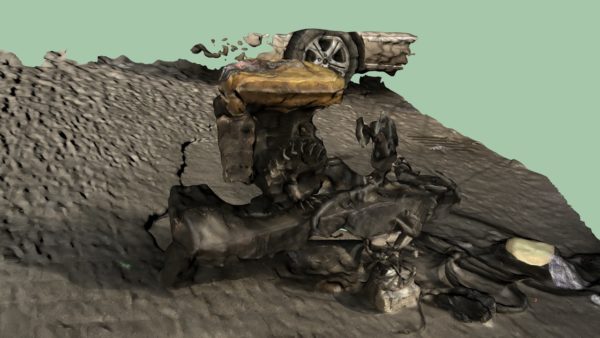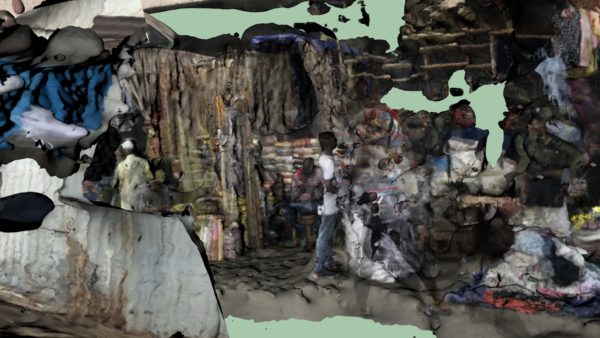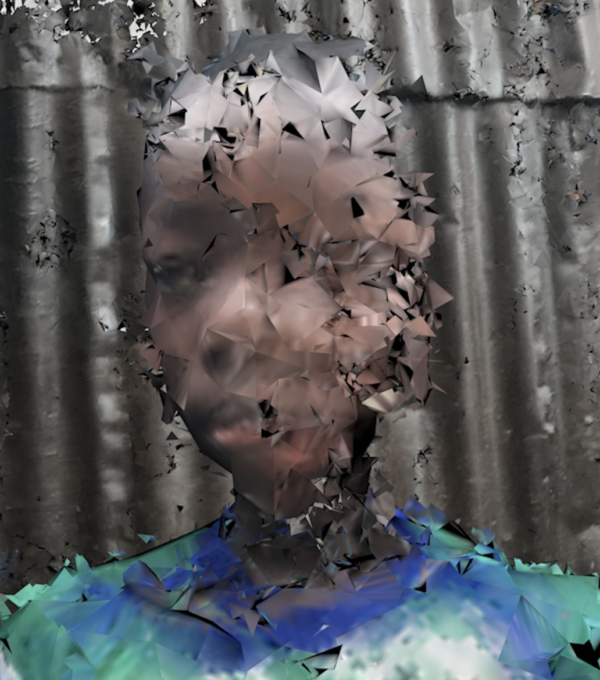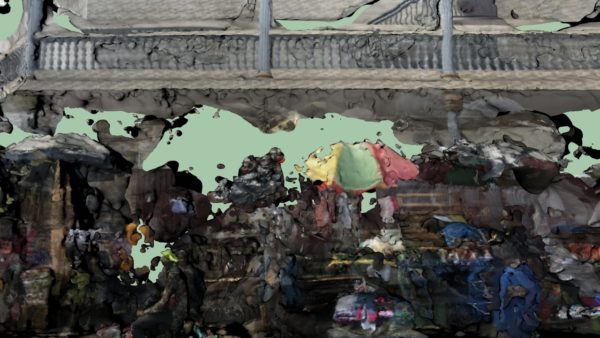How are artists, designers, and researchers engaging with the questions around digital colonialism and its impact? For our image contribution, we invited multidisciplinary artist Ibiye Camp to share her work ‘Data, the New Black Gold’ which explores how data has materialised in the West African landscape and the spatial consequences of its production, consumption, and storage.
Ibiye’s work engages with technology, trade, and material within the African Diaspora. For this special image contribution, stills and short video clips of ‘Data, the New Black Gold’ are interspersed between a text that came out of a conversation that Ibiye and Margarita Osipian had about her work.
‘Data, the New Black Gold’ emerged out of a longer line of research interests that Ibiye had related to the Diaspora, her own identity and perspective as a British Nigerian, and looking at how technologies are used in West Africa and how they are used in the UK. During her trips to West African countries, like Sierra Leone and Nigeria, Ibiye became interested in the entrepreneurial ways in which technology was being used and gaming spaces in Sierra Leone. This merged with her studies at Royal College of Art where she focused on post-human institutions, data centres, and digital infrastructures. It was through this research that Ibiye began to see the divide in how multinational corporations were both taking land and taking control of public data, and the way citizens were being treated in relation to these extractive practices. Out of this emerged the question of whether there was a way for citizens to collect their data and for that data to become a source of value for them.

‘Data, the New Black Gold’ is set in two West African cities: Lagos, Nigeria (which is considered Africa’s tech hub) and Freetown, Sierra Leone. In 2019, the president of Sierra Leone, Julius Maada Bio, had a lot of ambitions to make the country a hub for technology and innovation, working on nanotechnology, blockchain, and cloud computing. Through Ibiye’s perspective, travelling to both cities, there was an interesting parallel in their relationship to, and development of, digital technologies: “In my research I was looking at the fibre optic cables and their landing points, and where data centres were. Lagos had eight data centres, which is a lot for a West African country, and that’s why Lagos was particularly a point of interest. And because of what Sierra Leone’s gone through, with Ebola and the Civil War, there is more informal technology like gaming centres and mobile top up places. So I was looking at what kinds of points of data exchange there would be—at the PlayStation hubs or where people top up their phones or mobile money transfer hubs.” Ibiye was comparing the intense digital infrastructures of Lagos and the more informal entrepreneurial side of digital technologies in Sierra Leone, trying to understand their relationship to the extraction of data.

With Facebook building 2Africa—one of the largest subsea cable projects in the world that will interconnect 23 countries in Africa, the Middle East, and Europe—and with the ongoing monopoly on digital infrastructure by U.S. companies, how can we resist the extractive practices of digital colonialism? In ‘Data, the New Black Gold’, Ibiye explores how data could be utilised to give restitution to citizens during this time of technological investment and development from overseas. Is there a way to invert these typical power structures? As Ibiye points out during our conversation, the infamous 419 Nigerian prince scam is used to extract money and information, but when large tech companies extract these same resources it is not considered criminal or a scam. Ibiye sees these things as the same, and data as something that can be used to make a profit, harness information, and control citizens.

In many African countries most internet traffic goes through the mobile network, and mobile internet access is steadily accelerating. Rudimentary scanning tools and simple photogrammetry became the medium for Ibiye’s work, as they were simultaneously accessible via smartphones but also revealed biases embedded in scanning systems. Just like coded bias exists in facial scanning devices and facial recognition algorithms, where people with darker skin tones are not recognised as much as caucasian people, there is also a bias in terms of how we scan and understand the landscape through digital technologies. The way these scanning systems understood landscapes and objects, and their inability to recognise things that are black or not well lit according to Western standards of lighting, opened up bigger questions around data biases and the imbalances between organisations, companies, and citizens.
The act of scanning became central to her project when Ibiye started using her phone to scan the street at Balogun market on Lagos Island. As Ibiye pointed out “if you look at this street on Google Maps, it’s a clear street. It looks super empty. You can go through Google Maps, as if you’re walking through the street. But it’s not the way the street functions. And it’s not the way the street works.” What was interesting for Ibiye is that when she was scanning the street herself, when everyone was present and using the street, it became a unique form of street data that Google could never really capture or understand because Google needs spaces to be clear in order to navigate with their Google car. As Ibiye pointed out, “the scans that I created are like an imperfect digital world, which is also creative and really amazing because the voids and the visibility show how these spaces resist technology and can’t be captured.” From this came her idea for restitution for people, who could collect these imperfect digital scans of market stalls, shops, or mangoes that are being sold on the street—collecting a huge database about how the market runs, about the daily scenes, which is outside of the hands of corporations.
In the act of collecting data through rudimentary scanning devices, the glitch is formed. For Ibiye, “the glitch is a point to design within, it’s almost like the entry point into a design problem or a kind of opening into a new way of seeing”. While scanning, Ibiye realised that there was a whole other narrative emerging within the glitch, within the data voids and the imperfect scans. Photogrammetry was developed to scan sculptures and well lit buildings, but when applied to the Balogun market—with its cars, scooters, and busy stalls—the glitch happened because this was an imperfect scenario for these technologies. As Ibiye pointed out, this was “like a tension between the landscape and the technology”. While this project was a speculative project, existing as an example for how people could harness data, it opens up a lot of potentialities. Ibiye envisions people connecting their smart phones to their wheelbarrows and scanning the street as they move through it, scanning the market stalls and the mobile top-up shops.

And on a little side note, Ibiye also has an amazing clothing line that engages with her ideas around world building, representation, and the importance of making things visible. Check it out here.